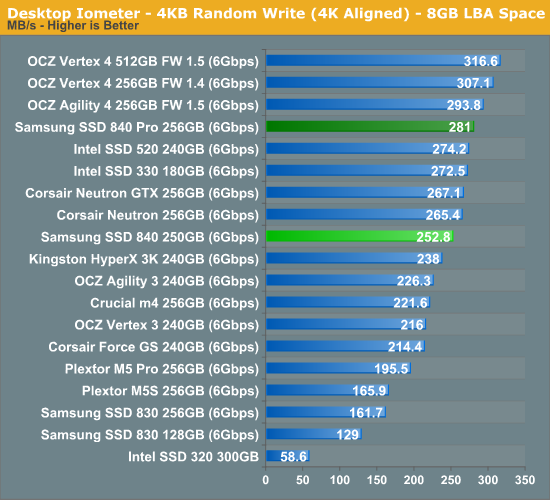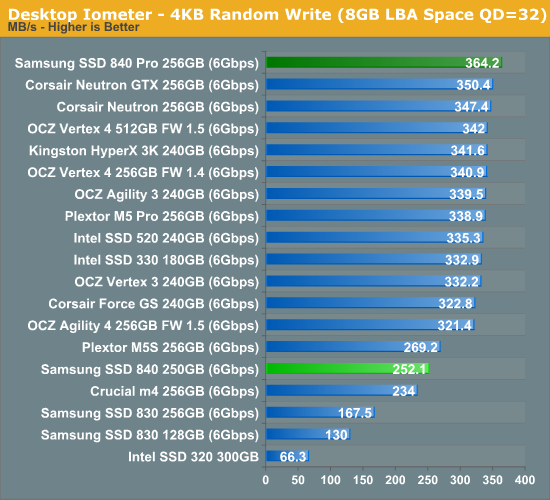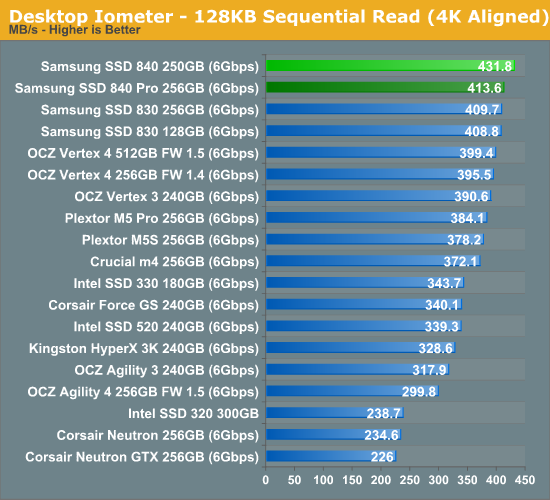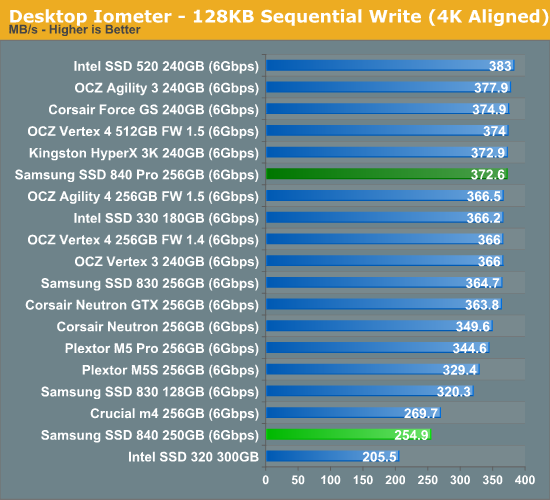Samsung SSD 840 (250GB) Review
by Kristian Vättö on October 8, 2012 12:14 PM EST- Posted in
- Storage
- SSDs
- Samsung
- TLC
- Samsung SSD 840
Random Read/Write Speed
The four corners of SSD performance are as follows: random read, random write, sequential read and sequential write speed. Random accesses are generally small in size, while sequential accesses tend to be larger and thus we have the four Iometer tests we use in all of our reviews.
Our first test writes 4KB in a completely random pattern over an 8GB space of the drive to simulate the sort of random access that you'd see on an OS drive (even this is more stressful than a normal desktop user would see). I perform three concurrent IOs and run the test for 3 minutes. The results reported are in average MB/s over the entire time. We use both standard pseudo randomly generated data for each write as well as fully random data to show you both the maximum and minimum performance offered by SandForce based drives in these tests. The average performance of SF drives will likely be somewhere in between the two values for each drive you see in the graphs. For an understanding of why this matters, read our original SandForce article.

Random read speed is good but not 840 Pro level. Some of this can be due to the slower NAND as the queue depth of our random read test is only 3—with higher queue depths the difference between 840 and 840 Pro should be closer.


Random write speed is a bit odd as performance does not scale up with higher queue depths. Speculating on the cause is difficult, but if I had to guess I would say it's firmware related, not NAND this time. Samsung is most likely doing some very aggressive write combining and caching so it's easy to achieve the same level of performance regardless of queue depth.
Sequential Read/Write Speed
To measure sequential performance I ran a 1 minute long 128KB sequential test over the entire span of the drive at a queue depth of 1. The results reported are in average MB/s over the entire test length.

Samsung's read centric firmware approach with the 840 really shows off in our low queue depth sequential read test: there is no drive faster than it.

Sequential write is pretty poor compared to today's other 256GB SSDs but Samsung is only claiming 250MB/s so this shouldn't come as a surprise. The similarity between random and sequential write speed helps back up what we mentioned earlier: Samsung is likely being very aggressive with its write combining to make random IOs look very sequential.










86 Comments
View All Comments
travbrad - Wednesday, October 10, 2012 - link
I had a 80GB WD that lasted 8 years without failing. I eventually had to stop using it simply because it was too slow. I also had a 250GB WD drive that I used for 5 years (then switched to all SATA). Now I have a 640GB drive that I've been using for almost 4 years. My brother has a couple 500GB drives in his system that have been running for 4-5 years as well.Maybe I've just been really lucky, but the only drive I've personally had fail in the last decade was a Hitachi drive (obviously selected for cost not quality) in my HP laptop.
Now at work it's a different story. Those pre-built machines cut every corner they can to bring costs down so they end up with low quality components (especially PSUs). Even in that situation there is a fairly low number of hard drive failures though (considering how old most of the machines are)
mapesdhs - Friday, October 12, 2012 - link
I have SCSI disks that are more than 20 years old which still work fine. :D
Ian.
MarkLuvsCS - Monday, October 8, 2012 - link
Considering Write Amplification has been significantly reduced compared to the initial SSD tech, I don't believe it's going to be a problem for the consumer market. Google xtremesystems Write Endurance to see a Samsung 830 256gb with 3000 P/E still running at 4.77 PETABYTES.That page also shows you other brands and how they fare. I would trust Samsung wouldn't put this tech to use without truly understanding how it would pan out.That is why the worry of the 1000 P/E 840 vs 3000 P/E 830 is overblown. Either way you have little to worry about with Samsung's controllers causing any fuss unlike Other CompanieZ.
Kjella - Monday, October 8, 2012 - link
Not giving one fsck about wearing out the SSD I burned through a 10k-rated SSD in 1.5 years. Now with fairly normal SSD usage - a standard Win7 desktop with torrents etc. on other drives - I'm down to 57% health and looking at 3 years 10 months on a 5K-rated drive. I don't know exactly what is eating it but I'm guessing every log file, every time MSN or IRC logs a line of chat, every time something is cached or whatever it burns write cycles. I feel the official numbers are vastly *overstating* the actual lifespan, not understating it. TLC with 1K writes? Not in my machine, no sir.madmilk - Monday, October 8, 2012 - link
There's no way MSN/IRC can burn through an SSD in 1.5 years since they're all text. You must be doing something unusual, or at least your computer is without you knowing it. A good idea would be to open up Task Manager, and select the columns that count the number of bytes written by various programs. Maybe then you can find the source of your problem. Also make sure you have defragmentation off, and sufficient RAM so you're not constantly hitting the pagefile.piiman - Tuesday, February 19, 2013 - link
Better yet put the page file on a different drive and also move your temp folders to a different drive.Notmyusualid - Tuesday, October 9, 2012 - link
Absolutely hilarious ending there pal... I wonder how many people got it!I got burned by them on a couple of drives, and promptly dumped them on some well-known auction site, sold as-is.
creed3020 - Tuesday, October 9, 2012 - link
I see what you did there ;-)Great review Kristian! I'll be looking at this drive as option for a new office PC I am building.
B3an - Monday, October 8, 2012 - link
Did you people even bother to read?? Because you're conveniently missing out the important fact in this article that you'd have to write 36.5TiB (almost 40TB) a year for it to last 3.5 years. I know for a fact that the average consumer does not write anywhere near that much a year, or even in 3 years. If anyone even comes close to 40TB a year they would be using a higher-end MLC SSD anyway as they would surely be using a workstation.Most consumers don't even write 10GB a day, so at that rate the drive would easily last OVER 20 years. But of course it's highly likely something else would fail before that happens.
You're also forgetting out DSP which is explained in this article as well. That can also near double the life.
I think Kristian should have made this all more clear because too many people don't bother to actually read stuff and just look at charts.
futrtrubl - Monday, October 8, 2012 - link
Granted the usual use cases won't have so much data throughput. However those same usual use cases have the user filling 3/4 of the drive with static data (program/OS/photo archive etc) reducing the drive area it's able to wear level over. So that 20 years again becomes 5 years.Also the 1000PE cycle stat means that there is a 50% chance for that sector to have become unusable by that time (ignoring DSP).
I'm not saying that TLC is bad, and I am certainly not saying this drive doesn't have great value. I'm just saying that we shouldn't understate the PE cycle issue.